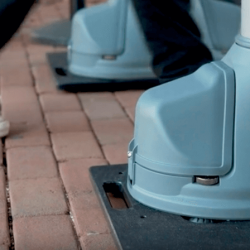What is the initial cost of a school weapons or metal detector?
In today’s world, ensuring the safety and security of our educational institutions is paramount. As schools explore various security measures, one critical consideration is the cost of implementing and maintaining weapons or metal detectors. This article talks about the main things that schools must think about when they plan to invest in these systems, and compare those costs from each manufacturer. These include the initial costs of the detectors, staff training, and the ongoing cost of maintenance and support of the system, along with staffing.
Understanding the full financial commitment along with the return on your investment is crucial for making informed decisions that prioritize student safety. Additionally, we will highlight the benefits of choosing a comprehensive solution like the OPENGATE®, which includes or considers the latest technology, robust support, and effective training programs versus the cost from other manufacturers. By the end of this guide, you will be equipped with the knowledge to make a well-rounded decision about investing in these important security measures.
Questions you should ask about initial costs of a school weapons detector
When evaluating the initial costs of a school weapons detector, several key questions must be addressed to ensure a comprehensive understanding of the budgetary needs.
The first question is; how many detectors you need?
While some simply think about the number of entrances to a building or event venue, that is not the most important variable. Whether you’re screening students on their way into school in the morning, screening for sports and public events or both, you need to determine how many detectors you need to ensure your number of students can get to class on time, and so that you don’t have visitors waiting in a long line to get into an event, which is a security risk. The measure of the number of students passing through the detector is commonly referred to as throughput. In other words, how many students\people can a weapons detector help you effectively screen every 30 or 60 minutes.
While all weapons detectors are designed for\market their solutions for efficient visitor throughput, the real-world throughput numbers will vary from manufacturer to manufacturer, especially depending on the threat items you want to be able to detect.
For conservative numbers, you should be able to securely screen 600 students every 30 minutes through a single weapons detector security line, on their way into school in the morning. Your overall throughput number must include secondary screening if and when students alert, because you need to ensure they can get to class on time as well.
For sports and public events, you should be able to conservatively screen 2500-2700 per hour through a single security lane. But again, this will vary from manufacturer to manufacturer.
You will also want to ask manufacturers what their average alarm rate is, for screening students in the morning and for sports\public events, based on what you want to be able to detect. The alarm rate can vary significantly from manufacturer to manufacturer, which will affect your overall throughput, especially if your alarm rate is high.
Portability vs moveability is a critical factor in determining how many detectors you will need. As an example, can you easily move the weapons detectors from the front of the school to the gymnasium, performing arts center, football field or event venue?
Questions to ask:
- How much does a single detector weigh?
- How many people does it take to move a detector?
- How long does it take to move and set back up so that it is fully operational again?
- Does it run on a standard 110volt outlet?
- Can it run on rechargeable batteries?
- If so, how long will the detector operate without having to re-charge the batteries?
- Are the batteries manufactured by the weapons detector company or a proven, commercial battery manufacturer, so that you can easily purchase more on your own?
This will vary depending on the type and sophistication of the system, as well as the number of entry points that need to be secured. Understanding this figure is crucial for establishing a baseline for your budget.
While considering portability you should also consider versatility. Can the weapons detector also be used as a traditional metal detector if and when needed? As an example, the ability to change the sensitivity setting of a weapons detector to the same sensitivity as a traditional metal detector to enhance your security posture as a result of a reported threat or lockdown situation could be invaluable. Can one detector achieve that or do you need to purchase separate metal detectors?
The answer to all of the questions above will not only help you determine your actual costs, but you also be thinking about the overall return on your investment of a weapons detector.
Next, consider the cost of installing the system if there is one. Installation expenses can include labor, materials, and any necessary modifications to the school’s electrical and physical infrastructure. This is an important aspect to factor into your initial investment, as it can significantly impact the overall timeline and financial outlay. Ensuring that the installation is done correctly is vital for the system’s effectiveness and longevity.
What are the ongoing costs of a school weapons detector?
Learn more about what ongoing costs you may expect from your weapon detectors.
Why OPENGATE® is the solution
CEIA’s OPENGATE® is a cutting-edge weapons detection system for schools, efficiently screening students and teachers with backpacks, purses, and bags. Its technology lets it quickly and easily screen people. This helps to reduce disruption and alarms. OPENGATE® is lightweight and easy to set up. It is great for both indoors and outdoors, making it safer in all kinds of schools.
There are no maintenance fees because CEIA’s long history of manufacturing expertise ensures that no maintenance is required. As a result, technical phone support is also available 24\7\365.
Gallery








